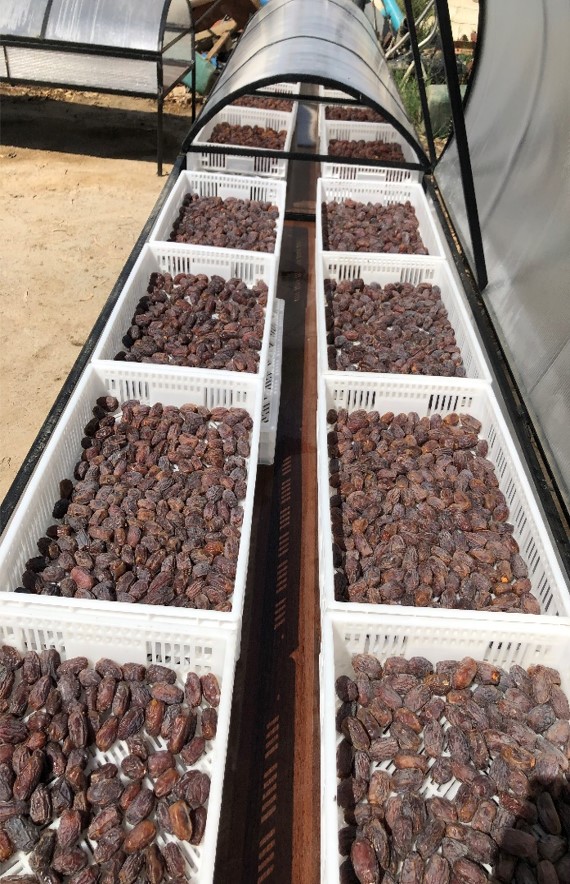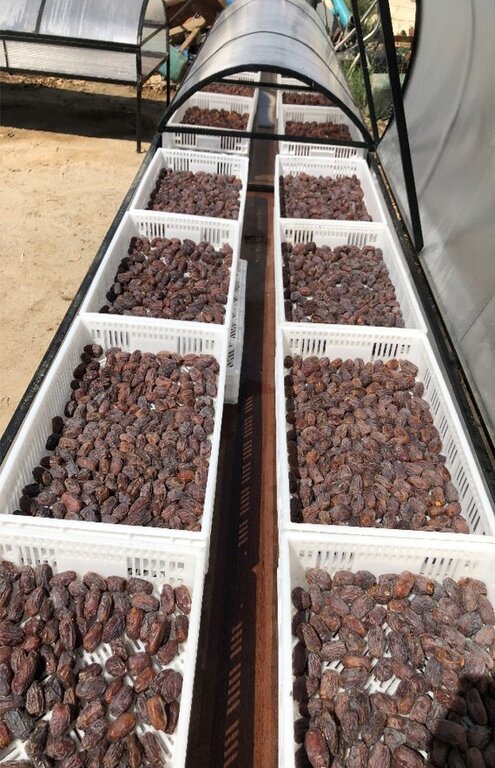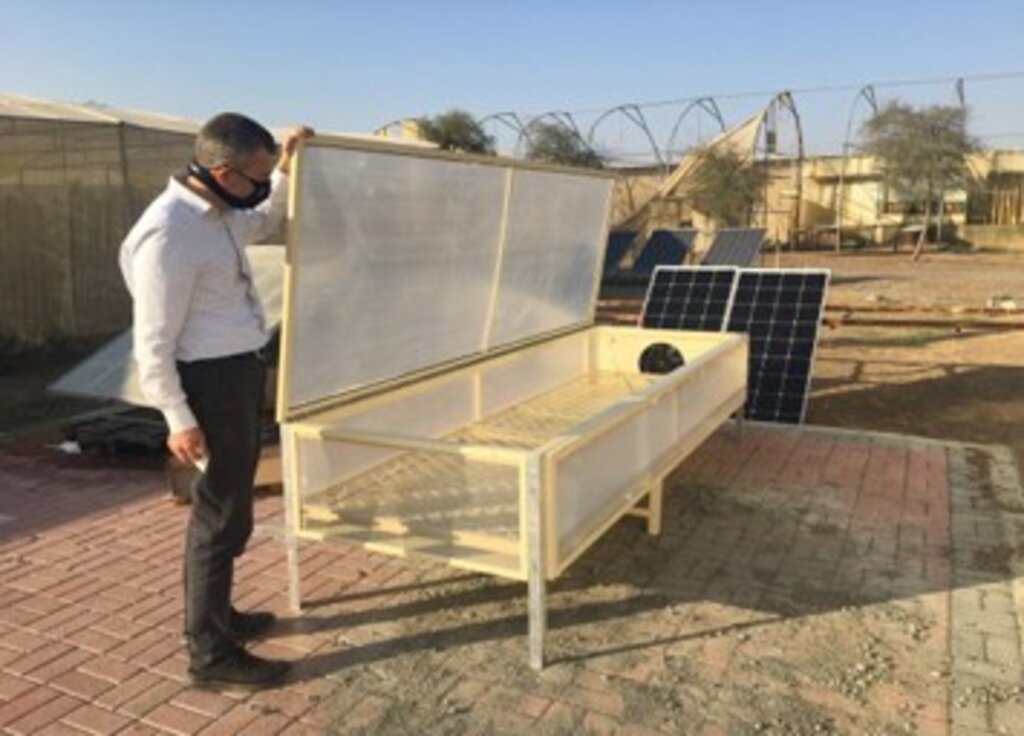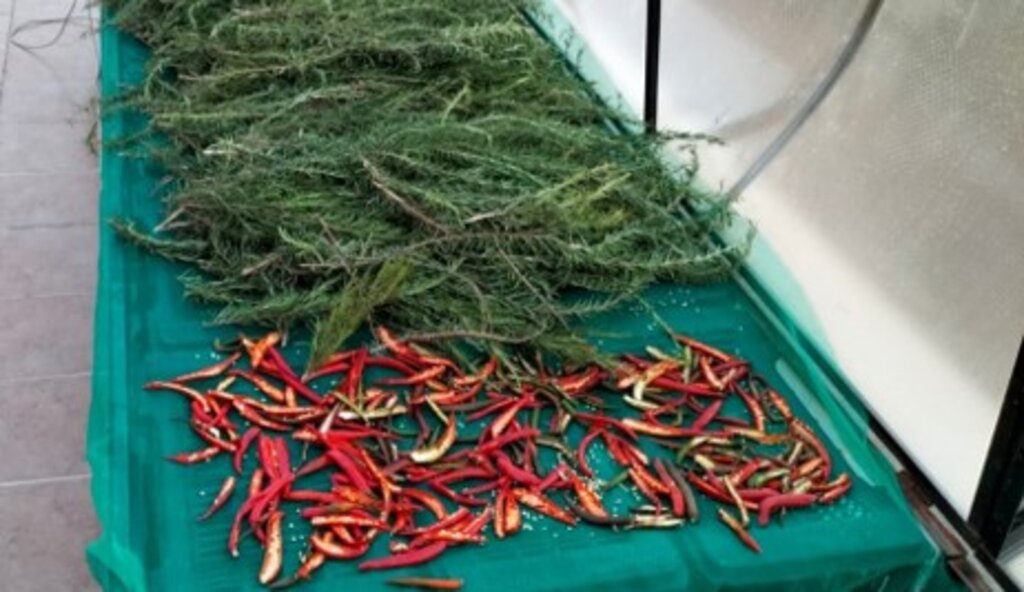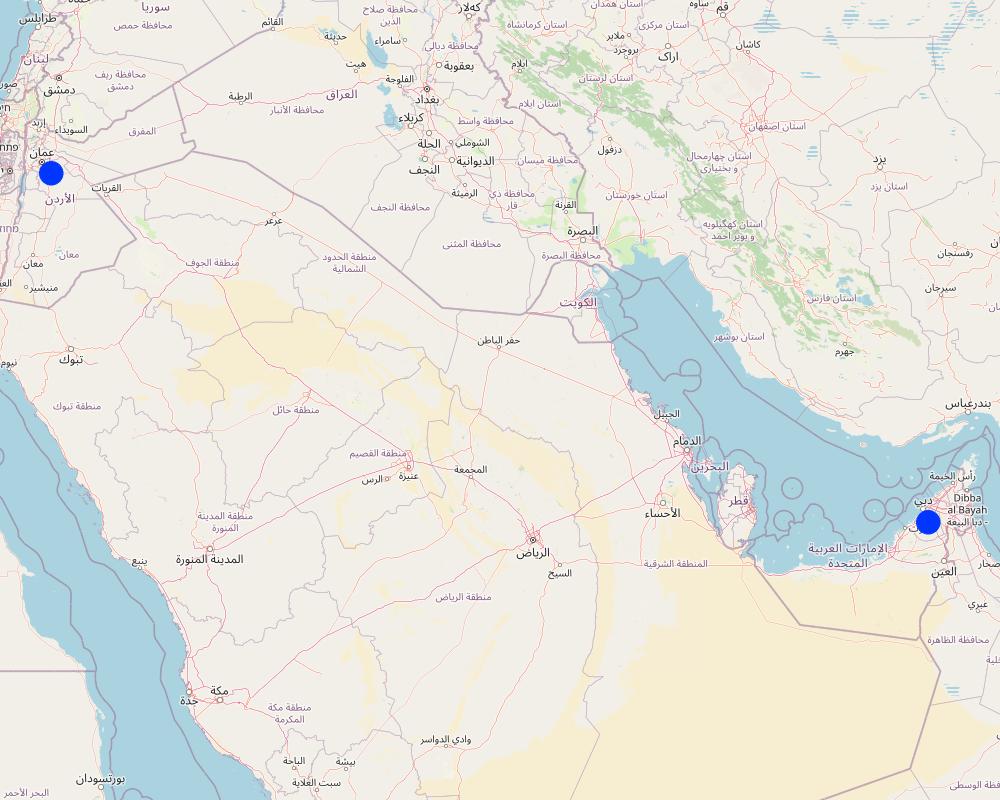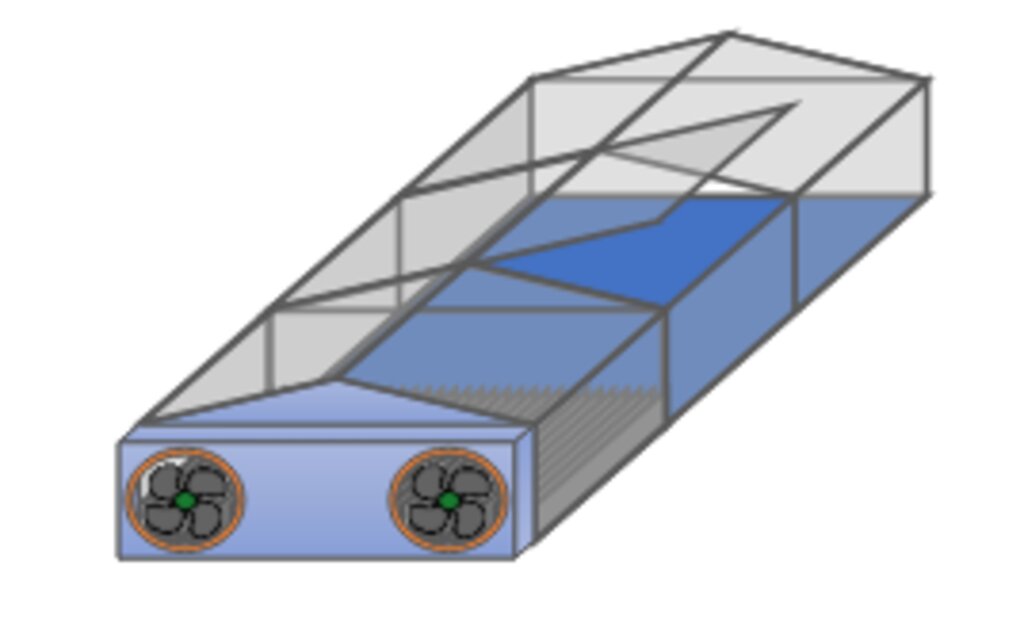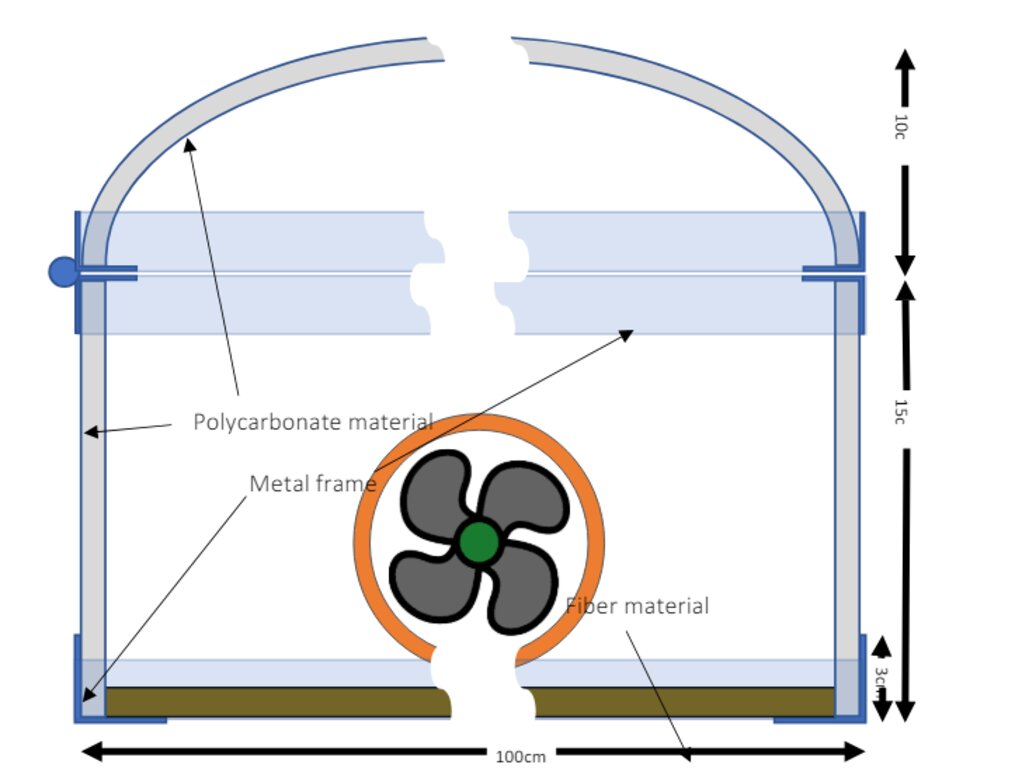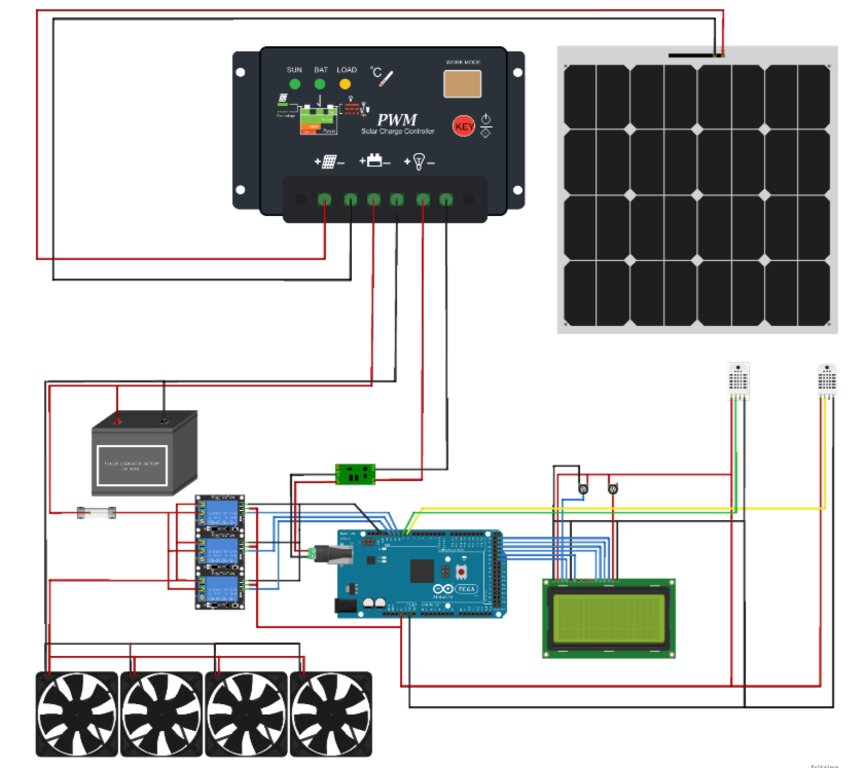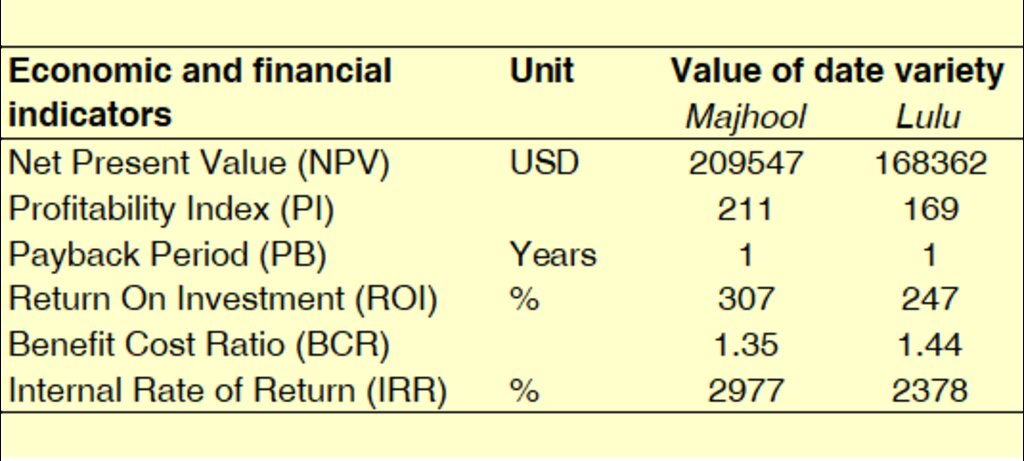Solar Mobile Dryer (SMD) [Emirats arabes unis]
- Création :
- Mise à jour :
- Compilateur : Joren Verbist
- Rédacteur : –
- Examinateurs : William Critchley, Rima Mekdaschi Studer
technologies_7197 - Emirats arabes unis
Voir les sections
Développer tout Réduire tout1. Informations générales
1.2 Coordonnées des personnes-ressources et des institutions impliquées dans l'évaluation et la documentation de la Technologie
Personne(s)-ressource(s) clé(s)
Principal Natural Resources Economist:
Dhebibi Boubaker
International Center of Agriculture Research in the Dry Areas (ICARDA)
Tunisie
Food and Feed Processing Scientist:
Hilali Muhi El-Dine
International Center of Agriculture Research in the Dry Areas (ICARDA)
Jordanie
Activities Coordinator Officer:
Nejatian Arash
International Center of Agriculture Research in the Dry Areas (ICARDA)
Emirats arabes unis
Regional Coordinator APRP:
Niane Abdoul Aziz
International Center of Agriculture Research in the Dry Areas (ICARDA)
Emirats arabes unis
Nom du projet qui a facilité la documentation/ l'évaluation de la Technologie (si pertinent)
ICARDA Institutional Knowledge Management InitiativeNom du ou des institutions qui ont facilité la documentation/ l'évaluation de la Technologie (si pertinent)
International Center for Agricultural Research in the Dry Areas (ICARDA) - Liban1.3 Conditions relatives à l'utilisation par WOCAT des données documentées
Le compilateur et la(les) personne(s) ressource(s) acceptent les conditions relatives à l'utilisation par WOCAT des données documentées:
Oui
1.4 Déclaration sur la durabilité de la Technologie décrite
Est-ce que la Technologie décrite ici pose problème par rapport à la dégradation des terres, de telle sorte qu'elle ne peut pas être déclarée comme étant une technologie de gestion durable des terres?
Non
2. Description de la Technologie de GDT
2.1 Courte description de la Technologie
Définition de la Technologie:
The innovative Solar Mobile Dryer (SMD) developed by ICARDA addresses climate change challenges for date palm growers in the Gulf Cooperation Council (GCC) countries by improving fruit quality, reducing waste, saving energy, and enhancing profitability, thereby supporting sustainable and efficient agricultural practices.
2.2 Description détaillée de la Technologie
Description:
In the Middle East, the date palm is an essential crop with significant cultural and economic value, thriving in dry, arid, and hot climates. However, climate change is exacerbating production challenges, with higher temperatures, heatwaves, water scarcity, harsh winds, leading to poor pollination, and increased pests amongst other issues. Small-scale date palm producers in the Gulf Cooperation Council (GCC) countries face additional problems of managing unsold or excess produce. Short harvesting periods and high deterioration rates of some date varieties make the situation worse. A common solution to extend shelf life is freezing. However, this has several drawbacks including storage and handling difficulties, nutrient and flavour degradation, and high energy costs.
To tackle these post-harvest challenges, the International Center of Agricultural Research in Dry Areas (ICARDA) developed an innovative Solar Mobile Dryer (SMB) for drying dates, achieving the desired colour for marketing while shielding the produce from dust and rain. The mobile solar dryer includes tables with polycarbonate covers forming a tunnel. Each table is 3 meters long, 1 meter wide, with walls 15-30 cm high, and raised 40 cm off the ground on metal legs. Dates are placed on a mesh for enhanced air flow and drying. Temperatures are kept at 70 degrees Celsius, the same as industrial date drying, to avoid textural changes, hardness, and colour alteration. Two versions of the tables have been produced.
The Jordan version, uses an iron frame and includes four tables that can form a 12-meter tunnel. This dryer has a 12V 40W DC fan, with a control unit and solar panel system, providing 6 hours of operation during the day and 2 hours at night, controlled by a temperature sensor.
The second version was developed in United Arab Emirates (UAE) and features a lighter aluminium frame and a 12V 80W fan fixed on one table. It includes temperature and humidity sensors, two solar panels, and a 20A charging controller.
The advantage and disadvantages of the SMB are as follows:
Advantages:
+ Improves fruit quality, especially in humid areas. Produce dried in greenhouses are often higher quality than those sun-dried.
+ Prevents contamination by insects, birds, dust, and rain.
+ Saves energy and drying time, improves product quality, and increases process efficiency.
+ Solar drying systems have low operation and maintenance costs.
+ Reduces waste and loss rates.
+ Reduces air pollution and greenhouse gases from fossil fuels.
+ Can be used for other products (e.g., fruits, vegetables, medicinal, and aromatic plants).
Disadvantages:
- Drying is limited to sunny days unless integrated with conventional energy systems. Drying without sunshine depends on the humidity difference between inside and outside the chamber.
- Solar drying is slower than conventional fuel or electricity-based dryers.
- Requires large land areas and long drying times, subject to solar radiation and temperature fluctuations.
- Farmers may lack maintenance knowledge for the system.
Economic evaluations of the SMD for two date varieties, Majhool and Lulu, demonstrate high profitability. The initial investment in the SMD is approximately 1,000 USD, with an estimated lifetime of about 10 years. The drying process takes between 1 and 3 days. The SMD has a capacity to dry between 6 and 12 kilograms of dates per square meter of drying surface in the SMD, resulting in production of around 5-10 kilograms of dried dates. Maintenance costs are estimated at 25% of the initial investment, while variable costs such as labour, packaging, and transportation are around 500 USD per month. Based on these figures, the net income per kilogram of dried dates is approximately 2.7 USD. Depending on the date variety, the return-on-investment ranges between 240% and 310%, with a payback period of about 4 months. These numbers indicate that the innovation is highly profitable for farmers.
The SMD is a crucial ICARDA initiative for smallholder date palm growers in the GCC countries, offering energy savings, waste reduction, and post-harvest loss prevention, enhancing the competitiveness of modern agriculture in high date production areas.
We express our sincere gratitude to the Gulf Cooperation Council (GCC) Secretariat for funding this research under the "Development of sustainable date palm production systems in the GCC countries of the Arabian Peninsula" project. We are grateful to the Ministries of Agriculture, Agricultural Authorities, and Agricultural Research Institutions and Universities in the GCC countries for their continuous support and collaboration in implementing project activities.
2.3 Photos de la Technologie
2.5 Pays/ région/ lieux où la Technologie a été appliquée et qui sont couverts par cette évaluation
Pays:
Emirats arabes unis
Spécifiez la diffusion de la Technologie:
- appliquée en des points spécifiques ou concentrée sur une petite surface
Est-ce que les sites dans lesquels la Technologie est appliquée sont situés dans des zones protégées en permanence?
Non
Map
×2.6 Date de mise en œuvre de la Technologie
Indiquez l'année de mise en œuvre:
2020
2.7 Introduction de la Technologie
Spécifiez comment la Technologie a été introduite: :
- au cours d'expérimentations / de recherches
- par le biais de projets/ d'interventions extérieures
3. Classification de la Technologie de GDT
3.1 Principal(aux) objectif(s) de la Technologie
- améliorer la production
- s'adapter au changement et aux extrêmes climatiques et à leurs impacts
- atténuer le changement climatique et ses impacts
- créer un impact économique positif
- créer un impact social positif
3.2 Type(s) actuel(s) d'utilisation des terres, là où la Technologie est appliquée
Les divers types d'utilisation des terres au sein du même unité de terrain: :
Non

Terres cultivées
- Plantations d’arbres ou de buissons
Plantations d'arbres et d'arbustes - Précisez les cultures:
- dattes
Nombre de période de croissance par an: :
- 1
3.3 Est-ce que l’utilisation des terres a changé en raison de la mise en œuvre de la Technologie ?
Est-ce que l’utilisation des terres a changé en raison de la mise en œuvre de la Technologie ?
- Non (Passez à la question 3.4)
3.4 Approvisionnement en eau
Approvisionnement en eau des terres sur lesquelles est appliquée la Technologie:
- mixte: pluvial-irrigué
3.5 Groupe de GDT auquel appartient la Technologie
- mesures post-récoltes
3.6 Mesures de GDT constituant la Technologie

autres mesures
Précisez:
This is a post-harvest and technological innovation.
3.7 Principaux types de dégradation des terres traités par la Technologie

dégradation biologique
- Bq: baisse de la quantité/ biomasse
3.8 Prévention, réduction de la dégradation ou réhabilitation des terres dégradées
Spécifiez l'objectif de la Technologie au regard de la dégradation des terres:
- prévenir la dégradation des terres
- réduire la dégradation des terres
Commentaires:
This innovation increases the income of the farmers per unit area i.e., increased economic land productivity. This allows farmers to reduce pressure on the land and/or to manage their land more sustainable.
4. Spécifications techniques, activités, intrants et coûts de mise en œuvre
4.1 Dessin technique de la Technologie
Spécifications techniques (associées au dessin technique):
Schematic view of the SMD
Fans blow air to control humidly and temperature. Top windows can be open to store and collect dates, but also for manual control of temperature etc.
Auteur:
ICARDA
Date:
2022
Spécifications techniques (associées au dessin technique):
Side view dimensions of the SMD.
Plastic (poly-carbonate) sheets are held up by an iron frame. The product lay on a plastic net to also support vertical airflow.
Auteur:
ICARDA
Date:
2022
Spécifications techniques (associées au dessin technique):
Technical schematic overview of the SMD
Auteur:
ICARDA
Date:
2022
Spécifications techniques (associées au dessin technique):
Electronic parts and connections overview of the SMD
Drawn using Fritzing software, www.fritzing .org
Auteur:
ICARDA
Date:
2022
Spécifications techniques (associées au dessin technique):
Net Present Value (NPV)
NPV evaluates an investment's profitability by calculating the difference between the present value of cash inflows and outflows. A positive NPV indicates a profitable investment, while a negative NPV signals a potential loss.
Profitability Index (PI)
PI measures the relative profitability of an investment by comparing the present value of future cash inflows to the initial investment. A PI greater than 1 indicates a good investment, whereas a PI less than 1 suggests it may not be viable.
Payback Period (PB)
PB is the time it takes for an investment to recover its initial cost through cash inflows. A shorter PB is preferred as it indicates quicker recovery, though it doesn't account for the time value of money or cash flows after the payback period but provides implication for risk.
Return on Investment (ROI)
ROI assesses the efficiency or profitability of an investment by comparing the net gain to the cost. A higher ROI indicates a more profitable investment.
Benefit-Cost Ratio (BCR)
BCR evaluates the value for money of a project by comparing the present value of benefits to costs. A BCR greater than 1 suggests benefits exceed costs, making the project worthwhile, while a BCR less than 1 indicates the opposite.
Internal Rate of Return (IRR)
IRR is the discount rate at which the NPV of all cash flows from an investment equals zero. If IRR exceeds the required rate of return, the investment is considered good. It's useful for comparing projects.
Auteur:
ICARDA
Date:
2022
Spécifications techniques (associées au dessin technique):
Schematic drwing of the SMD as used in Jordan
Auteur:
ICARDA
Date:
2024
4.2 Informations générales sur le calcul des intrants et des coûts
Spécifiez la manière dont les coûts et les intrants ont été calculés:
- par entité de la Technologie
Indiquez la monnaie utilisée pour le calcul des coûts:
- dollars américains
4.4 Coûts et intrants nécessaires à la mise en place
| Spécifiez les intrants | Unité | Quantité | Coûts par unité | Coût total par intrant | % des coût supporté par les exploitants des terres | |
|---|---|---|---|---|---|---|
| Equipements | Charger control 1 (off grid, 12v 20A) | 1,0 | ||||
| Equipements | Fuse (10A) | 2,0 | ||||
| Equipements | Switch (10A) | 2,0 | ||||
| Equipements | DC relay (16A) | 1,0 | ||||
| Equipements | Sensors (temperature and humidity) | 1,0 | ||||
| Equipements | Arduino micro processor | |||||
| Equipements | LCD screen (2x20) | 1,0 | ||||
| Equipements | DC relay (4 relay module) | 1,0 | ||||
| Matériaux de construction | Polycarbonate board (8-10mm) | 2,0 | ||||
| Matériaux de construction | Dark fiber board (6mm) | 2,0 | ||||
| Matériaux de construction | Metal bars (3cm x 3cm x 10mm) | 20,0 | ||||
| Matériaux de construction | Metal bars (2m x 2m) | 10,0 | ||||
| Matériaux de construction | Metal hinges (small, <10mm) | 8,0 | ||||
| Matériaux de construction | Fan (12v 40-80W) | 1,0 | ||||
| Matériaux de construction | Battery (12v 55A) | 1,0 | ||||
| Matériaux de construction | Solar panel (170W 12v) | 2,0 | ||||
| Autre | Voltage regulator (1-40v) | 1,0 | ||||
| Autre | Plastic terminal box (30cm x 40cm) | 1,0 | ||||
| Autre | Clock module (5v) | 1,0 | ||||
| Autre | SD card module (5v) | 1,0 | ||||
| Autre | BCP board | 2,0 | ||||
| Autre | Total costs | 1,0 | 1000,0 | 1000,0 | ||
| Coût total de mise en place de la Technologie | 1000,0 | |||||
| Coût total de mise en place de la Technologie en dollars américains (USD) | 1000,0 | |||||
Si vous n'êtes pas en mesure de décomposer les coûts dans le tableau précédent, donnez une estimation du coût total de la mise en place de la Technologie:
1000,0
4.6 Coûts et intrants nécessaires aux activités d'entretien/ récurrentes (par an)
| Spécifiez les intrants | Unité | Quantité | Coûts par unité | Coût total par intrant | % des coût supporté par les exploitants des terres | |
|---|---|---|---|---|---|---|
| Autre | Maintenance | 1,0 | 250,0 | 250,0 | ||
| Autre | Variable (use) cost | 1,0 | 500,0 | 500,0 | ||
| Coût total d'entretien de la Technologie | 750,0 | |||||
| Coût total d'entretien de la Technologie en dollars américains (USD) | 750,0 | |||||
4.7 Facteurs les plus importants affectant les coûts
Décrivez les facteurs les plus importants affectant les coûts :
Material costs for drying such as packaging appeared to be a major cost.
5. Environnement naturel et humain
5.1 Climat
Précipitations annuelles
- < 250 mm
- 251-500 mm
- 501-750 mm
- 751-1000 mm
- 1001-1500 mm
- 1501-2000 mm
- 2001-3000 mm
- 3001-4000 mm
- > 4000 mm
Zone agro-climatique
- semi-aride
- aride
5.2 Topographie
Pentes moyennes:
- plat (0-2 %)
- faible (3-5%)
- modéré (6-10%)
- onduleux (11-15%)
- vallonné (16-30%)
- raide (31-60%)
- très raide (>60%)
Reliefs:
- plateaux/ plaines
- crêtes
- flancs/ pentes de montagne
- flancs/ pentes de colline
- piémonts/ glacis (bas de pente)
- fonds de vallée/bas-fonds
Zones altitudinales:
- 0-100 m
- 101-500 m
- 501-1000 m
- 1001-1500 m
- 1501-2000 m
- 2001-2500 m
- 2501-3000 m
- 3001-4000 m
- > 4000 m
Indiquez si la Technologie est spécifiquement appliquée dans des:
- non pertinent
5.3 Sols
Profondeur moyenne du sol:
- très superficiel (0-20 cm)
- superficiel (21-50 cm)
- modérément profond (51-80 cm)
- profond (81-120 cm)
- très profond (>120 cm)
Texture du sol (de la couche arable):
- moyen (limoneux)
Texture du sol (> 20 cm sous la surface):
- moyen (limoneux)
Matière organique de la couche arable:
- faible (<1%)
5.4 Disponibilité et qualité de l'eau
Profondeur estimée de l’eau dans le sol:
5-50 m
Disponibilité de l’eau de surface:
faible/ absente
Qualité de l’eau (non traitée):
faiblement potable (traitement nécessaire)
La qualité de l'eau fait référence à:
à la fois les eaux souterraines et de surface
La salinité de l'eau est-elle un problème? :
Oui
La zone est-elle inondée?
Non
Commentaires et précisions supplémentaires sur la qualité et la quantité d'eau:
Because the SMD is mobile and processes the harvest, the natural situation is not that essential. However, ideally, it should be placed in warm and sunny areas.
5.5 Biodiversité
Diversité des espèces:
- faible
Diversité des habitats:
- faible
5.6 Caractéristiques des exploitants des terres appliquant la Technologie
Sédentaire ou nomade:
- Sédentaire
- Semi-nomade
Orientation du système de production:
- exploitation mixte (de subsistance/ commerciale)
Revenus hors exploitation:
- 10-50% de tous les revenus
Niveau relatif de richesse:
- pauvre
Individus ou groupes:
- individu/ ménage
- groupe/ communauté
Niveau de mécanisation:
- travail manuel
- mécanisé/ motorisé
Genre:
- hommes
Age des exploitants des terres:
- jeunes
- personnes d'âge moyen
- personnes âgées
5.7 Superficie moyenne des terres utilisées par les exploitants des terres appliquant la Technologie
- < 0,5 ha
- 0,5-1 ha
- 1-2 ha
- 2-5 ha
- 5-15 ha
- 15-50 ha
- 50-100 ha
- 100-500 ha
- 500-1 000 ha
- 1 000-10 000 ha
- > 10 000 ha
Cette superficie est-elle considérée comme de petite, moyenne ou grande dimension (en se référant au contexte local)?
- petite dimension
5.8 Propriété foncière, droits d’utilisation des terres et de l'eau
Propriété foncière:
- individu, sans titre de propriété
- individu, avec titre de propriété
Droits d’utilisation des terres:
- individuel
Droits d’utilisation de l’eau:
- individuel
Est-ce que les droits d'utilisation des terres sont fondés sur un système juridique traditionnel?
Oui
5.9 Accès aux services et aux infrastructures
santé:
- pauvre
- modéré
- bonne
éducation:
- pauvre
- modéré
- bonne
assistance technique:
- pauvre
- modéré
- bonne
emploi (par ex. hors exploitation):
- pauvre
- modéré
- bonne
marchés:
- pauvre
- modéré
- bonne
énergie:
- pauvre
- modéré
- bonne
routes et transports:
- pauvre
- modéré
- bonne
eau potable et assainissement:
- pauvre
- modéré
- bonne
services financiers:
- pauvre
- modéré
- bonne
6. Impacts et conclusions
6.1 Impacts sur site que la Technologie a montrés
Impacts socio-économiques
Production
production agricole
Commentaires/ spécifiez:
(Economic) Productivity increases because post-harvest losses decrease and selling prices increase
qualité des cultures
Commentaires/ spécifiez:
Because of the drying, products are considered higher quality
Revenus et coûts
dépenses pour les intrants agricoles
Commentaires/ spécifiez:
To reach the higher selling prices additional expenses on the SMD and packaging is required.
revenus agricoles
charge de travail
Impacts socioculturels
sécurité alimentaire/ autosuffisance
Commentaires/ spécifiez:
Dried products have longer shelf life and less vulnerable to mold and pests.
situation des groupes socialement et économiquement désavantagés
Commentaires/ spécifiez:
SMD is so designed that it can be easily shared, so that costs for individual smallholder farmers are relatively low.
6.2 Impacts hors site que la Technologie a montrés
impact des gaz à effet de serre
Commentaires/ spécifiez:
The SMD only uses solar, so overall less greenhouse gasses are emitted, within the chain, compared to the current situation.
6.3 Exposition et sensibilité de la Technologie aux changements progressifs et aux évènements extrêmes/catastrophes liés au climat (telles que perçues par les exploitants des terres)
Changements climatiques progressifs
Changements climatiques progressifs
| Saison | Augmentation ou diminution | Comment la Technologie fait-elle face à cela? | |
|---|---|---|---|
| températures annuelles | augmente | très bien |
6.4 Analyse coûts-bénéfices
Quels sont les bénéfices comparativement aux coûts de mise en place (du point de vue des exploitants des terres)?
Rentabilité à court terme:
légèrement positive
Rentabilité à long terme:
très positive
Quels sont les bénéfices comparativement aux coûts d'entretien récurrents (du point de vue des exploitants des terres)?
Rentabilité à court terme:
très positive
Rentabilité à long terme:
très positive
6.5 Adoption de la Technologie
- cas isolés/ expérimentaux
De tous ceux qui ont adopté la Technologie, combien d'entre eux l'ont fait spontanément, à savoir sans recevoir aucune incitation matérielle, ou aucune rémunération? :
- 0-10%
6.6 Adaptation
La Technologie a-t-elle été récemment modifiée pour s'adapter à l'évolution des conditions?
Oui
autre (précisez):
other inputs
Spécifiez l'adaptation de la Technologie (conception, matériaux/ espèces, etc.):
Experiments are done with other products such as vegetables, fruits, and spices.
6.7 Points forts/ avantages/ possibilités de la Technologie
| Points forts/ avantages/ possibilités du point de vue de l'exploitant des terres |
|---|
| Increased farm income |
| Points forts/ avantages/ possibilités du point de vue du compilateur ou d'une autre personne ressource clé |
|---|
| Improvement of the fruits’ quality |
| No contamination of dates by insects, birds, dust and rain |
| Energy and drying time saving |
| Waste and loss rate reduction |
| Air pollution and greenhouse gases reduction |
| Multiuse purposes (vegetables, medicinal and aromatic plants-MAPs, etc.) |
| Production of the SMD can result in (local) employment opportunities |
6.8 Faiblesses/ inconvénients/ risques de la Technologie et moyens de les surmonter
| Faiblesses/ inconvénients/ risques du point de vue du compilateur ou d'une autre personne ressource clé | Comment peuvent-ils être surmontés? |
|---|---|
| Drying can be performed only during sunny days unless the system is integrated with a conventional energy-based system | |
| Solar drying process is slow in comparison with dryers that use conventional fuels | The avoidance of costs to fuel may compensate this. |
| Solar drying requires larger land areas and longer drying times | |
| Fluctuations in solar radiation and ambient temperature | |
| Farmers lack of knowledge for the maintenance of the system | Capacity building programme or training when buying the SMD |
7. Références et liens
7.1 Méthodes/ sources d'information
- interviews/ entretiens avec les spécialistes/ experts de GDT
- compilation à partir de rapports et d'autres documents existants
7.3 Liens vers les informations pertinentes en ligne
Titre/ description:
Boubaker Dhehibi, Muhi El-Dine Hilali, Arash Nejatian. (15/9/2023). Economic and Financial Evaluation of a Low-Cost Portable Solar Dryer for Maturing and Drying of Dates: Business for Development (B4D) Report.
URL:
https://hdl.handle.net/20.500.11766/68749
Titre/ description:
Muhi El-Dine Hilali, Arash Nejatian, Abdoul Aziz Niane, Mohamed Ali Bob. (30/11/2023). دليل تصنيع و تشغيل المجفف الشمسي المتنقل. Beirut, Lebanon: International Center for Agricultural Research in the Dry Areas (ICARDA).
URL:
https://hdl.handle.net/20.500.11766/69302
Titre/ description:
Muhi El-Dine Hilali, Arash Nejatian. (28/3/2021). Developing solar drier for maturing and drying of dates in the Arabian Peninsula. Lebanon: International Center for Agricultural Research in the Dry Areas (ICARDA).
URL:
https://hdl.handle.net/20.500.11766/12826
Liens et modules
Développer tout Réduire toutLiens
Aucun lien
Modules
Aucun module trouvé


